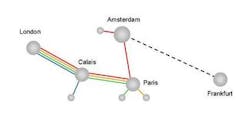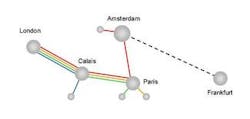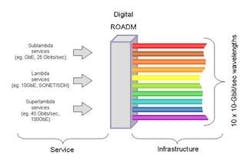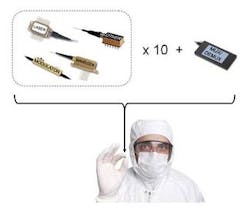Digital ROADMs: Completing the promise of the optical network revolution
Due to their analog nature, ROADMs have significant limitations, including limited management capability, lack of subwavelength multiplexing, and the inability to exploit the full benefits of a GMPLS control plane. However, a new class of ROADM, based on digital technology, is now emerging to address these limitations and deliver a range of additional benefits to the service provider.
By Geoff Bennett, Infinera
Carriers now have direct operational experience with deploying all-optical, reconfigurable optical add/drop multiplexers (ROADMs), and it is becoming clear from this experience that ROADMs incur some unanticipated costs and do not offer the kind of flexibility needed to support the Internet's current growth rate. Designed in the last century to deliver low-cost, flexible network capacity, ROADMs may not be fit for today's environment. This article examines three specific areas where ROADMs have shown shortcomings and looks at a simple approach to return digital capabilities to this century's optical networks.
The all-optical revolution
Something funny happened when SONET/SDH met DWDM. Because DWDM multiplied the number of SONET/SDH timeslots transmitted over a given fiber, it became uneconomical for service providers to keep the signal in the digital domain during its journey across the network. So many optical-electronic-optical (OEO) conversions would have been prohibitively expensive, and the additional active components required would have introduced significant reliability issues.
In the mid-1990s, the DWDM industry developed what it believed was the answer to this problem: the all-optical switch. The most common type of all-optical switch is the optical add/drop multiplexer (OADM), which is usually deployed in ring topologies. The all-optical approach aims to keep the majority of wavelengths in the optical domain as they transit the OADM and only add or drop the wavelength(s) that need to enter or exit the network at that point. This avoids the need for OEO conversion for the transit wavelengths and, theoretically, reduces the cost of the system.
Some OADMs use fixed filters that require an engineer to reconfigure the device whenever changes are made. Fixed-filter OADMs are the least expensive in terms of capital cost, but they are expensive in terms of operating expenditures (opex). As a result, newer (and much more expensive) reconfigurable OADMs were developed.
In a ROADM, selected wavelengths can be added or dropped by issuing commands from a central network management system (NMS), and a dynamic wavelength blocking or selection technology is used within the ROADM to carve off the add/drop traffic. Transit or "express" traffic still remains in the optical domain in a ROADM, and it is still necessary to send an engineer to the ROADM site to install the appropriate transponders to enable the delivery of tributary services to the customer.
As demand for high-speed Internet and private service bandwidth has increased, service providers have begun to deploy ROADMs on the assumption that the low operating costs they are seeing at the beginning of the deployment cycle would continue for the life of the product.
Unfortunately, this has not turned out to be true. There are four specific reasons why all-optical ROADMs are much more expensive to operate than was initially thought:
- Vulnerability to wavelength blocking.
- The need for external switching for wavelength and subwavelength bandwidth management.
- Limitations imposed on GMPLS.
- Lack of robust performance management and operations, administration, management, and provisioning (OAM&P).
Wavelength blocking. Figure 1 illustrates a typical ROADM deployment scenario where bandwidth needs to be deployed between London and Frankfurt. The all-optical vision says that the service provider simply adds transponders in London and Paris, turns on the wavelength at each hop, balances the power across each span, and starts using the service. But this vision only works when the network is first installed and plenty of wavelengths are available. In the C-band, for example, most ROADMs support 32 wavelengths and, in some cases, up to 40. Support for 80 wavelengths may be on the roadmap for some systems. But not all these wavelengths will be usable for the London to Frankfurt link because the same wavelength needs to be available on every span in the network.
As depicted in Figure 1, a number of wavelengths already have been used on this path by London-Calais (blue wavelength), London-Paris (orange and green wavelengths), and London-Amsterdam (red wavelength). And this diagram only details part of the problem. If the service provider is planning a resilient service, it must ensure that two contiguous wavelengths are available between the start and end points, and these usually will need to be routed over diverse paths. Planning tools can help to extract the maximum capacity, but they can never eliminate the wavelength blocking problem.
If a contiguous wavelength is not available, then the service provider has to plan for wavelength conversion somewhere en route. All-optical wavelength conversion is still not available, so wavelength conversion has to be implemented using OEO conversions in discrete optical components, which adds significantly to the cost.
A digital ROADM—a ROADM that converts the optical signal back into electronic form at each hop in the network—would solve the problems associated with wavelength blocking. A digital ROADM decouples the access services from the underlying transport layer.
Figure 2 depicts a single digital ROADM that supports a variety of services. Bandwidth from the digital ROADM is added into the backbone infrastructure using photonic integrated circuits (PICs). In one commercial PIC implementation, for example, bandwidth is added in 10-wavelength increments of 10 Gbits/sec per wavelength.
Capacity between digital ROADMs can be used by any kind of access service, including:
- Sublambda services multiplexed into the network by the built-in grooming circuits of the digital ROADM.
- Lambda 10-Gbit/sec services using a variety of access formats (e.g., SONET, SDH, 10-Gigabit Ethernet [10GbE] WAN PHY, 10GbE LAN PHY, etc.).
- Superlambda services, such as 40-Gbit/sec SONET/SDH, that are inverse multiplexed onto the backbone transparently to the access service.
In a digital ROADM network backbone, wavelengths have only local significance; it doesn't matter if a single wavelength is being used end-to-end on a link. Without wavelength blocking, service providers can extract 100% of the capacity from the network.
External switching versus digital ROADM integrated switching. Imagine a three-way junction in an all-optical network. The service provider needs to switch a service across this junction. If the service to be switched is a lambda-level service, such as 10GbE, a modern, multiway ROADM might be able to handle the switching function. But if sublambda or superlambda services are involved, a conventional all-optical ROADM would not suffice; an external OEO cross-connect would be required. Once again, a digital ROADM would solve both problems if electronic cross-connect capability could be built into the device in a cost-effective way. In fact, cross-connect chipsets are now widely available as commercial off-the-shelf components, but the difficulty for an all-optical ROADM is that expensive OEO conversion needs to take place before the cross-connect chip can do its job.
GMPLS limitations. Since about 2000, generalized MPLS (GMPLS) and ITU G.ASON have been positioned as the next-generation control plane for the optical network. However, an all-optical network presents a number of challenges when used as the foundation for a GMPLS control plane. For example, consider three things GMPLS does really well:
- Topology discovery and inventory management.
- Service provisioning and routing.
- Service protection and restoration.
First, topology discovery in an all-optical network can be difficult because of wavelength blocking. When two adjacent ROADMs are subject to wavelength blocking, each will be aware that a given wavelength is not available. But at this time, Open Shortest Path First-Traffic Engineering (OSPF-TE) technology does not support a mechanism to allow a third or more distant node to indicate wavelength blocking to upstream devices—that is, until a connection is attempted using Resource Reservation Protocol-Traffic Engineering (RSVP-TE). This problem is not insurmountable, but it does make the routing model much more complex.
Second, if you were to try to automatically route a connection across an all-optical network (e.g., using OSPF-TE), you would soon run into trouble. It would be necessary to include many complex metrics (such as fiber types, end-to-end loss, amplifier characteristics, dispersion profiles, etc.) in the routing update. Shortest path routing algorithms, such as the Dijkstra algorithm used in OSPF, assume that only one metric is used to determine the shortest path. In fact, algorithms that involve multiple metrics belong to a class of mathematical problems that are known as NP complete. In plain English, this means the algorithm will never converge on a solution. Even if you were able to shortcut the path selection process, it takes a long time to turn up a new wavelength in an all-optical ROADM network because of the interaction with in-line optical amplifiers. When a new wavelength is turned up in an erbium-doped fiber amplified (EDFA) network, it is essential to power-balance the entire set of wavelengths, which may involve the repeated adjustment of power levels on the link until all wavelengths are stable. For this reason, dynamic routing in an all-optical network is essentially impractical.
Finally, all-optical networks present real problems when it comes to automated service restoration. Wavelength blocking may mean that alternate routes are simply not available. Commercial systems solve this problem by storing backup paths for any given service. These backup paths will have been deployed in advance (i.e., transponders installed), power-balanced, tested, and then left idle in the network. In conventional ROADM systems, this capacity is allocated one wavelength at a time—a process that is both labor-intensive and time-consuming.
However, in one commercial implementation of digital ROADMs, PIC technology is used to allow backbone capacity to be allocated in chunks of 100 Gbits/sec (10 wavelengths at 10 Gbits/sec per wavelength). All the installation and balancing work now can be amortized over 10× the available capacity.
A digital ROADM would solve these problems and allow GMPLS to be deployed as it was originally conceived by its architects:
- Digital ROADMs can add or drop any wavelength service at any node, so there are no topology discovery limitations.
- Digital ROADMs terminate the complex optical layer at each hop, and individual link issues are zeroed out at each hop. The result is that a simple OSPF metric can be advertised for each wavelength on the backbone links.
- Modern digital ROADM implementations actually light up 10 wavelengths at a time on the network backbone. These wavelengths are already power-balanced and tested so tributary traffic can be routed over these connections as soon as the path is needed.
- Digital ROADMs do not suffer from wavelength blocking and therefore make full use of GMPLS-driven service protection and restoration.
Robust performance management and OAM. In the SONET/SDH world, carriers have access to a rich set of performance management and OAM functions. These functions help a carrier monitor services, detect faults (sometimes before they become noticeable to the service user), and perform remote management of services more quickly and efficiently than any other technology (e.g., Ethernet, IP, MPLS). Unfortunately, the move to DWDM analog transmission removes many of these functions because the digital characteristics of the service are no longer exposed at the intermediate points in the network. Traditional performance management and OAM can only be performed at the end points in a conventional ROADM network, and this can lead to higher operating costs and longer mean-time-to-repair (MTTR) figures for network services.
In a digital ROADM, the digital character of the service is available at every switching point, as it is in a SONET/SDH network. Carriers now have the same rich management capability for their DWDM services that they have always had with SONET/SDH. Faults can be detected and isolated immediately, which results in lower operating costs and happier customers.
Making the digital ROADM a reality
While digital ROADM technology appears to solve the problems associated with all-optical ROADMs, it would be prohibitively expensive to build such a device using conventional, discrete optical components. Figure 3 depicts the scale of the problem. In order to deal with an individual wavelength, a number of discrete optical components must be used at the transmit end of the fiber, including a DWDM (i.e., "colored") laser, a modulator, a variable optical attenuator (VOA) to stabilize the output power, and a wavelength multiplexer. PICs allow a number of these components to be combined together on a single chip.
Like the electronic integration revolution of the 1970s, photonic integration already has had an impact on the cost, functionality, size, and reliability of optical systems. For the first time, service providers have the option to go back to the highly deterministic and manageable world of digital communications and leave behind the "black magic" of all-optical.
In summary, the digital ROADM is resistant to wavelength blocking. It enables cost-effective, integrated subwavelength switching, and allows the full power of GMPLS to be brought to bear. Photonic integration is the technology that makes digital ROADMs affordable, compact, functional, and highly reliable.
Geoff Bennettis director of product marketing at Infinera (www.infinera.com). He may be reached at [email protected].



